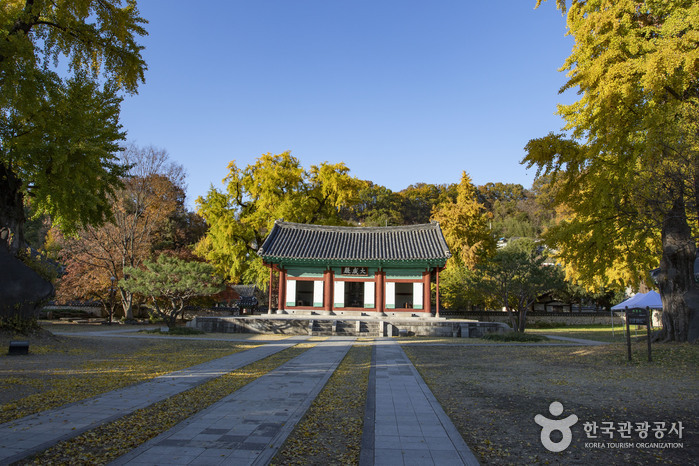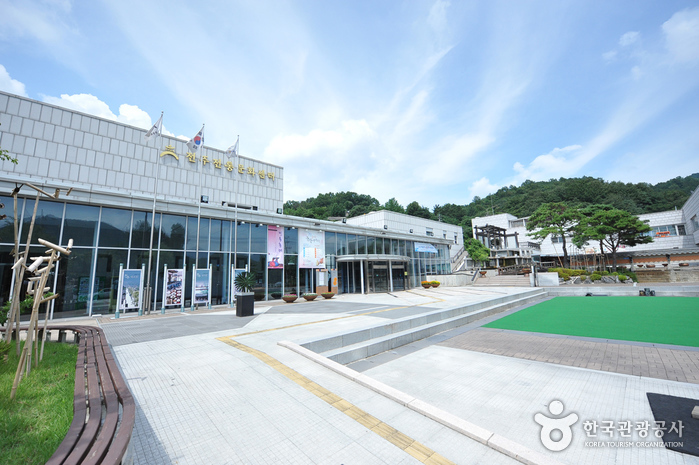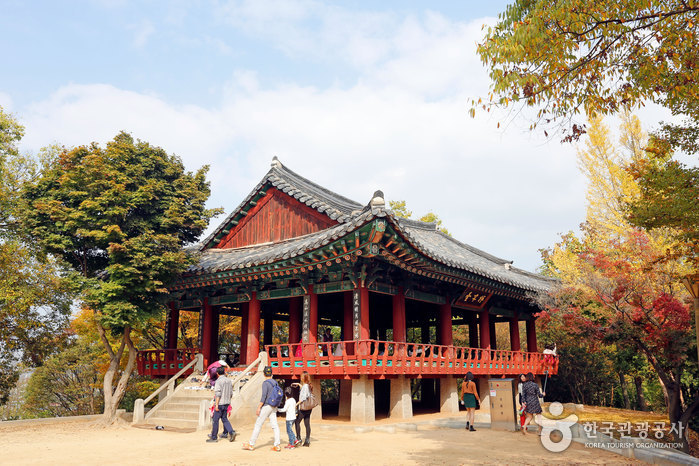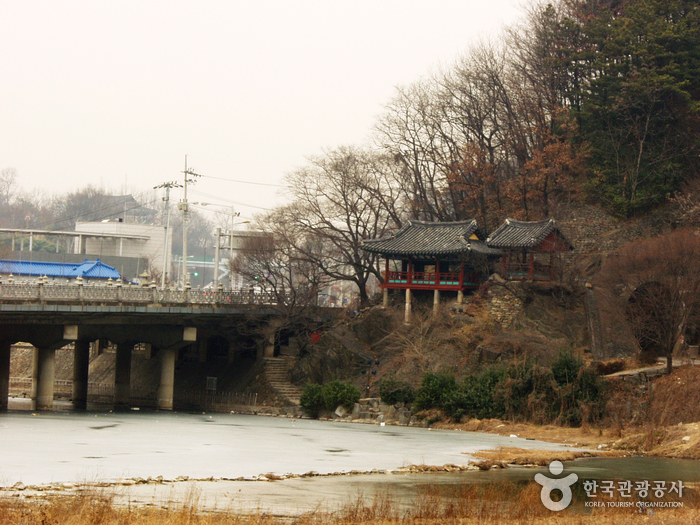Jeonju Hyanggyo (école confucéenne) (전주향교)
0m 6019 2024-04-08
139, Hyanggyo-gil, Wansan-gu, Jeonju-si, Région Jeonbuk
+82-63-288-4548
Fondée durant la dynastie Joseon (1392-1910), Jeonju Hyanggyo a été déclarée site historique n° 379. Signifiant « école provinciale », Hyanggyo était un établissement national d’éducation installé en province qui fournissait des enseignements confucianistes pendant la dernière dynastie coréenne. L’école confucéenne de Jeonju était située originairement aux alentours du lieu saint Geonggijeon, mais elle a été déplacée à son endroit actuel en 1603.
Elle abrite les plaques commémoratives de sept confucianistes chinois, y compris Confucius, et de dix-huit savants coréens dans le bâtiment principal appelé Daesungjeon. Composée de ce bâtiment et de seize autres, cette école figure parmi les plus grands établissements d’éducation de par sa taille.
Centre de la culture traditionnelle de Jeonju (전주전통문화관)
128.4366169188345m 2321 2023-04-06
20, Jeonjucheondong-ro, Wansan-gu, Jeonju-si, Région Jeonbuk
Le centre de la culture traditionnelle de Jeongju offre aux visiteurs un large panel sur les traditions, ainsi que la possibilité de voir des performances de chants « pansori » ou dances « minyo » traditionnels. Ceci, ouvert au public tout au long de l’année. Dans le hall des restaurants traditionnels il est possible de déguster divers spécialités tel que le bibimpap (riz avec des légumes) un des plats les plus réputés de Jeonju. Par ailleurs, un hall de mariages traditionnels accueillent les cérémonies de mariage.
Village des peintures murales de Jaman (자만벽화마을 - 외국어사이트용)
209.02864107315378m 273 2024-04-07
1-10, Jamandong 1-gil, Wansan-gu, Jeonju-si, Région Jeonbuk
Le village des peintures murales de Jaman est un petit village situé en face du village hanok de Jeonju, sur la colline d’une montagne. On peut trouver des maisons alignées les unes aux autres sur les pentes du village, sur les murs on trouve des peintures de toutes les couleurs.
Yedawon [Korea Quality] / 예다원 [한국관광 품질인증]
226.80980219909685m 184 2024-04-07
85-34, Hyanggyo-gil, Wansan-gu, Jeonju-si, Région Jeonbuk
+82-63-228-8218
Sitting at the foot of Omokdae, Yedawon is a classic Hanok opened in December 2013. It retains the unique beauty of Hanok, yet is equipped with neat and convenient facilities. The owner, who used to operate a traditional culture space for Hanok experience such as traditional tea and natural dying, newly built a Hanok for guests to be able to experience a cultural accommodation. Just one-minute away are Jeonjuhyangyo Confucian School and Jeonju Hanbyuk Culture Center, whereas the National Intangible Heritage Center is located over the Omokgyo Bridge outside the culture center. Gyenggijeon, Jeondong Catholic Cathedral, Omokgyo Bridge, and Nambu Market are all within walkable distance.
Yeodawon has six rooms named after flowers; ceilings with exposed rafters and crossbeams; walls with Hanji wallpapers; and decorations with black-and-white drawings and Korean calligraphy. In particular, Lotus Flower Room is furnished with a folding screen with a landscape painting on it, and a big black-and-white drawing.
Yeodawon is special in that guests can get first-hand experience of the traditional culture in different ways: traditional tea, traditional dying, Hanji, traditional dessert, traditional flower pancake, etc. The experience costs about 10,000 - 15,000 won per person, and available for four persons or more.
Omokdae et Imokdae (오목대와 이목대)
289.8942276876431m 6058 2024-04-08
1-3, Gyodong 1-ga, Wansan-gu, Jeonju-si, Région Jeonbuk
+82-63-281-2114
Omokdae, situé en haut d'une colline est le lieu où Yi Seong-gye (qui devint plus tard le Roi Taejo) s'arreta pour célébrer sa victoire lors d'une bataille contre l'armée japonaise au Mont Hwangsan à Unbong vers la fin de la période Goryeo. C'est aussi là où Mokjo, l'un des ancêtres de Yi Seong-gye, vécut. Plus tard, le Roi Gojong y établit une statue monumentale, “Taejogohwang Jejupilyujibi” avec une phrase écrite de sa propre main. De l'autre côté de Yukgyo, à partir d'Omokdae, se trouve Yimokdae, au pied du Mont Seungamsan où Chimyeongjasan, sité sacré pour les catholiques demeure. A 80 m de Yimokdae se trouvent un mémorial et une maison. “Mokjodaewang Gugeoyuji”, la phrase gravée sur le monument en pierre, fut écrite par le Roi Gojong en personne. Mokjo est le cinquième ancêtre du Roi Taejo, qui fonda la Dynastie Joseon. Imokdae est connue pour être le lieu où Mokjo vécut, jouant à des jeux de formation de bataille avec ses amis étant enfant. Cette anecdote apparait également dans le Yongbieocheonga (ballade du 15e siècle narrant la longévité nationale et la réussite culturelle). Mokjo se rendit à Hamgyeong-do à partir d'Imokdae (à Jeonju) en raison de la querelle qu'il eut avec le Jeonju Busan (officiel de l'etat gouvernant la région de Jeonju). Yi Seong-gye pensa que le départ de Mokjo était quelque chose ayant été guidé par les dieux afin qu'il (Yi Seong-gye) puisse fonder Joseon et devenir le premier roi de la dynastie.
Yangsajae [Korea Quality] / 문화공간 양사재 [한국관광 품질인증]
292.297080036725m 14399 2024-04-07
40, Omokdae-gil, Wansan-gu, Jeonju-si, Région Jeonbuk
+82-63-282-4959
Located in Jeonju Hanok Village, Yangsajae was the place where the poet Lee Byeong-gi (pen-name: Garam, sijo poet) composed his sijo (a Korean traditional poetic form) works. Now used as a cultural space, the house attracts many people looking for relaxation and cultural experiences.
Yangsajae, meaning “a house (jae) that cultivates (yang) classical scholars (sa)”, was an annex of the Jeonjuhyanggyo Confucian School where classical scholars used to study in preparation for the national civil service examinations. As an educational and creative place, Lee Byeong-gi composed sijo poems there for six years from 1951. It later served as the Jeonbuk Public Elementary School with the introduction of new learning to the Jeollabuk-do area in 1987. Since 2002, however, it has served as a hanok stay dedicated to promoting local history and traditions to the public. It is said that the building was constructed on a 400-year-old site about 150 years ago. In 1980, repair work was conducted to save the basic structure of the house.
The house is a typical ‘ㄱ’-shaped hanok structure with a half-hipped roof. In particular, the three dormitory rooms originally used by Confucian students and classical scholars can be converted into one single room for seminars, tea ceremonies, or other group meetings simply by opening the bunhapmun (sliding doors).
The guesthouse is a ‘ㅡ’-shaped hanok built in 1980. Each room has a clean and cozy interior with simple decoration and furniture. The rooms include the Gudeul (floor heated with firewood) Room, where the tea ceremony program using green tea leaves picked from the wild green tea field behind the house is held, and the Ondol (Korean floor heating system) Room.
As the poet Lee, who loved orchids, poems and alcohol, lived at Yangsajae, there are still traces of his former presence inside the house. Notably, Lee used the ‘Garamdasil’ room as his study room, so it displays some of his photos.
There is a postbox situated in a corner of the yard which the guests can use, and the owner will deliver the mail himself. Yangsajae is not only a hanok accommodation but also a multi-experience space where guests can discover traces of the old educational institute and the poet Lee’s life and works.
Tunnel Hanbyeok (한벽터널)
305.90774974631m 0 2024-04-08
Hanbyeok-dang, 7-3 San, Gyodong, Wansan-gu, Jeonju-si, Région Jeonbuk
Le tunnel Hanbeok est réputé pour ses vues romantiques apparues dans divers dramas en Corée, notamment "Twenty-Five Twenty-one".
Pavillon de Hanbyeokdang (한벽당)
321.9213771023967m 3079 2024-04-07
2, Girin-daero, Wansan-gu, Jeonju-si, Région Jeonbuk
+82-63-281-2166
Le Pavillon de Hanbyeokdang, situé dans la province du Jeollabuk-do, a été désigné propriété culturelle réelle No. 15. En 1404 lors du royaume de Joseon, un haut-fonctionnaire avait construit cette demeure comme résidence secondaire. Elle se trouve au pied du Mont Seungamsan donnant sur le splendide panorama du fleuve Jeonjucheon. Malheureusement, une autoroute a été créée dans les environs depuis, et la beauté du paysage en a souffert. Dans le passé, nombre d’écrivains étaient à la recherche du Pavillon de Hanbyeokdang afin de donner substance à leur inspiration. Ce dernier est aussi connu pour la beauté de la montagne qui l’entoure, ses brumes flottant au loin. C’est ainsi un des 8 lieux à voir absolument à Jeonju.
Hanokstory [Korea Quality] / 한옥이야기 [한국관광 품질인증]
326.1265904980351m 4018 2024-04-07
83-14, Eunhaeng-ro, Wansan-gu, Jeonju-si, Région Jeonbuk
+82-10-9203-1111, +82-10-4166-7799
Hanok Story in Hyanggyo-gil in Jeonju Hanok Village is a traditional Korean house built over 60 years ago and was recently renovated to serve as a guesthouse. Thus, it boasts of modern convenient facilities but preserves most of the features of a traditional Korean house, which was home to the guesthouse owner and his wife for over 35 years. The couple put old books, LPs, old movie posters, Korean lunch boxes, and old television on display in every corner of the house to create an old look and finish. In the yard is a 50-year-old persimmon tree that provides cool shade during the summer and delicious persimmons in the fall. All the old items in the house have a story to tell, and that's why the owner named his guesthouse "Hanok Story."
At the entrance of the house is a Korean phrase meaning “Enjoy the Five Blessings (longevity, wealth, health, love of virtue, and peaceful death) generation after generation with the energy of the sun, moon, and stars.” That’s why the rooms are named “Geumbit (Golden Light),” “Haetbit (Sunlight),” “Dalbit (Moonlight),” and “Byeolbit (Starlight).” The phrase is also engraved on top of the door to the "Haetbit Room." There are a total of seven guestrooms -- four in the main building and the "Solbit Room," "Deluxe Room No. 1," and "Deluxe Room No. 2." All the rooms are furnished with bathroom, TV, and air conditioner. Deluxe Room No. 2 has a kitchen for the guests to cook. There is a garden of sowbread, balloon vine, and hydrangea in the yard.
There is also a cafeteria made of cypress wood in the yard. The walls are covered with post-its left by the guests as well as musical instruments and dolls. It's where tea and breakfast are served. Homemade Korean breakfast is served for free. A tea class is also available during the weekend upon reservation.
Gyo Dong Sal Rae [Korea Quality] / 교동살래 [한국관광 품질인증]
358.6326526949582m 846 2024-04-07
66-1, Jeonjucheondong-ro, Wansan-gu, Jeonju-si, Région Jeonbuk
+82-10-9043-6743
Located at the entrance to Namcheongyo Bridge, which flows over Jeonjucheon Stream, Gyodongsalrae is a hanok structure built in 1971. It consists of the sarangchae (men’s quarters), anchae (women’s quarters), and byeolchae (detached House) and has ten guestrooms in total. While the sarangchae is situated near the road, the anchae and byeolchae are located to the rear of the house. Each building has a well-maintained flowerbed filled with seasonal flowers that harmonize perfectly with the beauty of the hanok.
The interior of the house is decorated with a variety of antiques, paintings, embroidery and knitting works, creating a cozy atmosphere. The ten rooms are of different sizes and styles including an ondol (Korean floor heating system) room, a room with a bed, and a darak (garret) room. The sarangchae consists of the Changpobang, Maehwabang, Baerongbang and Mokryeonbang rooms, of which the last two have a terrace with an open view. The anchae consists of a living room (sarangbang) and a room for two people. The byeolchae with a small courtyard has three large rooms with a capacity of four to six people and a separate space for relaxation and breakfast.



![Yedawon [Korea Quality] / 예다원 [한국관광 품질인증]](http://tong.visitkorea.or.kr/cms/resource/91/2594991_image2_1.jpg)

![Yangsajae [Korea Quality] / 문화공간 양사재 [한국관광 품질인증]](http://tong.visitkorea.or.kr/cms/resource/75/1879875_image2_1.jpg)


![Hanokstory [Korea Quality] / 한옥이야기 [한국관광 품질인증]](http://tong.visitkorea.or.kr/cms/resource/20/2046320_image2_1.jpg)
![Gyo Dong Sal Rae [Korea Quality] / 교동살래 [한국관광 품질인증]](http://tong.visitkorea.or.kr/cms/resource/71/2556371_image2_1.jpg)
 Français
Français
 한국어
한국어 English
English 日本語
日本語 中文(简体)
中文(简体) Deutsch
Deutsch Español
Español Русский
Русский